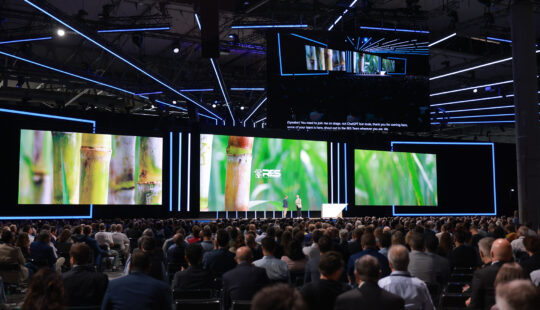Excitement was in the air at SAP Sapphire Orlando as the SAP SuccessFactors team showcased new innovations that use generative artificial intelligence (AI) to help organizations future-proof their business by unleashing the potential of their greatest asset: their people.
Watch the on-demand replay for the
SAP SuccessFactors demo for generative AI in HR.
With the recent announcement of SAP’s expanded partnership with Microsoft, the vision for enterprise-ready generative AI able to enhance human productivity and development in the workplace is becoming reality. The integration of SAP SuccessFactors solutions with Microsoft 365 Copilot and Copilot in Viva Learning will improve how organizations recruit, retain, and upskill their workforces to address skills gaps. In fact, 75% of business leaders say attracting and retaining critical talent is the No. 1 impediment to future growth and success.
“The skills gap is one of the biggest challenges that organizations are facing today,” said SAP SuccessFactors Chief Marketing & Solutions Officer Aaron Green, speaking to SAP customers during the HXM keynote. “As we talk to our customers around the world — and it doesn’t matter the region, the industry, the size of the organization — we hear one message: How can we change the way we think about skills? How can we be better prepared for the future?”
Transforming Business at Scale
To gauge the transformative scale of the collaboration of SAP SuccessFactors and Microsoft, it is helpful to look at the reach of both organizations. Today, more than 248 million people use SAP SuccessFactors software. It is the largest HR suite on the market and available in more than 100 localized frameworks to drive truly global business. As one of the world’s leading brands, Microsoft supports 1 billion people who use Microsoft Office and 280 million daily active users of Microsoft Teams.
“AI is fundamental to the future of business,” said Green, who put the power of generative AI for the enterprise into context for the audience. “AI is going to enable all of us to transform business at scale.”
Innovations that Future-Proof the Workforce
SAP SuccessFactors introduced three powerful innovations at SAP Sapphire that will help businesses future-proof their workforce and address critical skills gaps.
The first innovation comes with embedding generative AI capabilities, in partnership with Microsoft, to enhance recruiting and learning processes. Customers will be able to deliver dramatically improved experiences for employees. These experiences are embedded in the flow of work, so that employees will not need to switch between interfaces or apps to complete a routine task or learning activity. Also, hiring managers and recruiters will be able to create tailored job descriptions and better prepare for interviews — both of which include built-in checks for biased language — through the hyper-personalization capabilities of generative AI. These new capabilities were presented in the demo onstage during the main stage keynote at SAP Sapphire.
“We really believe in a big way in this notion of ‘in the flow of work,’” said Kirk Koenigsbauer, chief operating officer and corporate vice president of the Experiences and Devices Group at Microsoft, who shared insights during the panel discussion of the HXM keynote. “We think it’s paramount in terms of driving scale, reducing friction, and increasing the reach of HR systems into places where people are naturally working on a day-to-day basis. Our whole thesis is that if we can build these HR solutions into the flow of work, you’ll get much more adoption, you’ll get much more engagement… We’re really excited to work with SAP.”
A second key innovation is the introduction of a talent intelligence hub that uses AI to build, maintain, and infer a skills portfolio for each employee in the workforce. This depth of insight, using the whole-self model, enables employees to find personalized recommendations for learning courses, mentors, and internal jobs. Organizations benefit from having an overview of employee skills and improved visibility to carry out workforce planning.
“This is a moment where we can introduce a way to value workers differently: using data to help them grow in a way that makes sense for them while also supporting the needs within the business,” said Meg Bear, president and chief product officer for SAP SuccessFactors, in the panel discussion at the HXM keynote. “When we can create an environment where each person thrives, they’re going to be able to achieve a lot more for the business.”
The third innovation is enhanced total workforce management functionality that brings together SAP SuccessFactors, SAP Fieldglass, and SAP S/4HANA Cloud for increased workforce visibility across employees and external workers. A recent study found that 50% of organizations plan to source talent by increasing their use of external workers. A total workforce management strategy enables leaders to bring in skilled talent to fill roles in mission-critical projects at the right time.
These innovations are planned for availability in the 2H 2023 SAP SuccessFactors release.
Total Workforce Management for a Future-Ready Workforce
Standard Chartered, a leading international bank with a presence in 59 markets and a focus on Asia, Africa, and the Middle East, adopted total workforce management from SAP to remain competitive and compliant. Melinda McKinley, global head of HR Strategy and Digital Transformation at Standard Chartered, spoke with Green onstage at SAP Sapphire Orlando about what it meant for the organization to modernize its outdated, on-premise technology and how it enabled a future-ready workforce for its 83,000 employees and almost 14,000 external workers.
McKinley described how Standard Chartered applied a total workforce management strategy by integrating SAP SuccessFactors Employee Central with SAP Fieldglass software in the cloud to deliver a truly holistic capability across its permanent and contingent workforce. She shared that with the introduction of position management in October 2022, the bank achieved a breakthrough in its HR transformation journey. “One of the key things that set us on a path for a future-ready workforce was really embracing the foundational architecture that position management brings. That meant immediately we had a visualization of our total workforce — our contingent and our employee base, which is leading to more robust, data-driven hiring decisions.”
Standard Chartered remediated 75 interfaces to third-party systems and migrated 3.5 million data records from its legacy platform. It achieved an 87% reduction of reports and improved colleague experience with a new employee portal.
By taking a holistic view of its permanent and external workforce with total workforce management, the HR team at Standard Chartered set a foundation for integrated talent management, management of regulatory requirements, and strategic corporate planning in partnership with the finance team. “We’re working really closely with our finance colleagues to bring finance and HR data together a little more seamlessly through the use of SAP Analytics Cloud with the aim of making a real difference to bottom-up planning through our corporate plan,” McKinley said.
Standard Chartered transformed its HR processes with total workforce management and went on to win an SAP Innovation Award.
Developing a Growth Mindset
SAP is committed to a responsible approach to AI and was one of the first companies to define guiding principles for using AI in its software. In this framework, SAP SuccessFactors solutions use AI to streamline HR processes, enhance workforce planning, and help employees better navigate their careers. While many people are still trying to understand the scope and potential of AI technology, the experts in the panel discussion, each with decades of experience in the tech industry, offered their perspectives on how AI will shape the future of work.
“We think there is a big opportunity for AI, generally, to eliminate a lot of that mundane work,” said Koenigsbauer, who cited the potential for AI to help people access information differently and be more creative.
Bear agreed: “Work will change. We have to adapt as organizations and equip our workers with an understanding that this is an opportunity. Companies that embrace these shifting dynamics, that develop ways to improve because of them — those are the organizations that will grow and thrive.”



